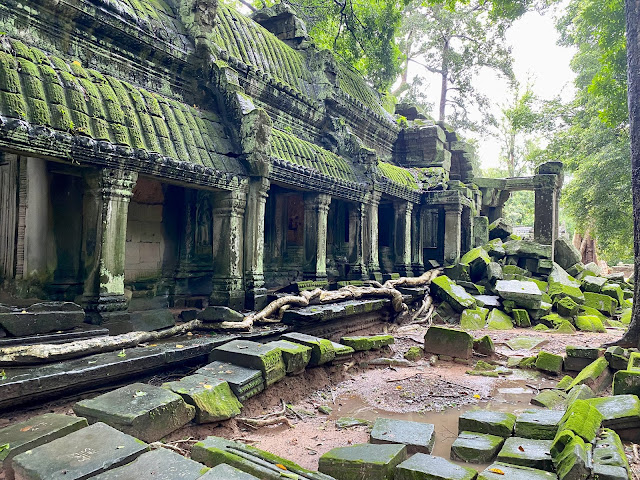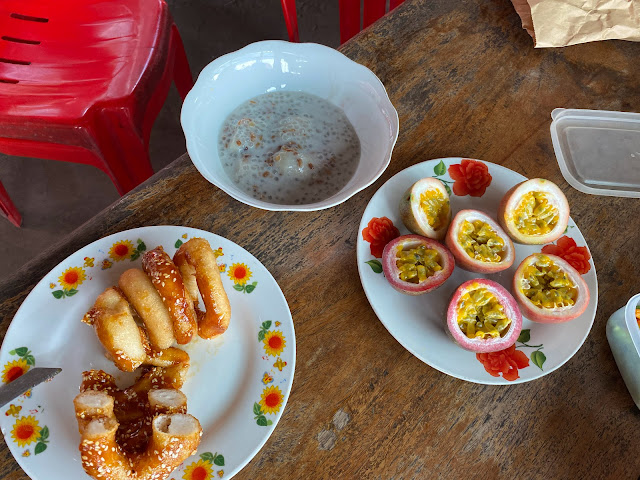My flight arrived earlier than my parents', so I got to experience taking the Phnom Penh city bus by myself to our picturesque hotel with multiple courtyards, cabanas, and pools. The first day, we realized early on how itineraries could be disrupted by COVID changes when we arrived at the closed Royal Palace.
We then went to the National Museum, a gallery of ancient artifacts and sculptures wrapping around a tranquil courtyard, and the first of many non-air conditioned museums that would test my dad's constitution.
 |
| The art deco Central Market |
After foot massages that evening, a local guide picked us up in a tuk-tuk to explore the city's food. I loved Cambodian food--lots of curries served with limes and plates full of foraged leaves, as well as desserts made of glutinous rice, black sesame, coconut milk, and fruits.
 |
| Banana flower wrapped in sticky rice steamed in banana leaves |
 |
| Lentil and fish paste curry on rice noodles, with raw greens |
 |
| Curry; seafood salad on glass noodles |
We ended the night at a rooftop bar. I love rooftop and alfresco dining, but it feels rather rare in Taipei. People always prefer to be inside in the air conditioning. My foreign friends and I get strange looks when we ask to sit at a restaurant's one outdoor table. I thought it was because of the humidity, but Phnom Penh was nearly as hot and even more humid than Taipei. As our guide said, Cambodians love being outside. I think maybe it has more to do with how Taipei residents show that they are "modern" or cosmopolitan, much along the lines of the argument that Lizzy van Leeuwen makes about the nouveau riche of Jakarta in her ethnography Lost in Mall.
The next day, we visited the Tuol Sleng Genocide Museum, which memorializes the human rights abuses and mass murder under the Khmer Rouge regime between 1975 and 1979. The Khmer Rouge was a radical communist movement led by Pol Pot that briefly took over the government and has been blamed for around 2 million excess deaths, around one fourth of Cambodia's population during that time. Their brutal policies involved forced relocation of Phnom Penh residents to the countryside as part of an extremist agrarian ideology. The Tuol Sleng Museum joined the ranks of the most sobering exhibits I've ever visited, including the 9/11 Memorial in NYC, the Apartheid Museum in Johannesburg, the Holocaust Memorial Museum in D.C., and the National Civil Rights Museum where MLK was assassinated in Memphis.
On an architecture tour that same day, we saw the impact that forced urban relocation under the Khmer Rouge had on the modern culture of squatting in Phnom Penh.
 |
| Makeshift homes built in an old cathedral |
 |
| Housing in/under a Buddhist temple |
 |
| An old French colonial style hotel divided among families of squatters--and a cat |
 |
| Cambodians put out little houses so the spirits will play on them instead of on their own houses' roofs |
The two main branches of Buddhism are Theravada Buddhism (more common in Cambodia) and Mahayana Buddhism (more common in Taiwan). Theravada Buddhist shrines will sometimes portray the Buddha as emaciated, whereas Mahayana Buddhism more commonly shows a fat, happy Buddha. It is very common for a Cambodian man to spend time as a Buddhist monk, often when mourning his parents' death. We saw many monks walking on the street (or riding on the back of a scooter) in their orange robes collecting alms. They are highly respected in society and can even receive free higher education.
 |
| Stupas holding the remains of the deceased |
Next, we went to the highly touristed, foodie town of Siam Reap. It was highly walkable with a nightlife street; it almost felt like Florida.
From there, most travelers take a bus or tuk-tuk to Angkor Wat, but my family decided to bike. The temples were astounding, formidable ruins surviving for the past thousand years while the jungle reclaimed the surrounding ancient city. On our bike ride home, it started raining heavier than I've ever experienced in my life. I could barely keep my eyes open to see the road in front of me. It was almost hard to breathe through the pouring rain. By the time we got back to our hotel's street, we were all happily biking through foot-deep puddles of warm water with the rest of traffic. It was a highlight of the trip.

































No comments:
Post a Comment